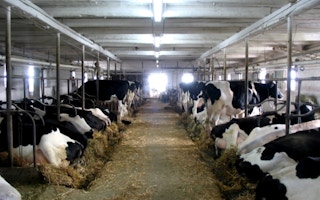“Build back better. Blah, blah, blah. Green economy. Blah blah blah… This is all we hear from our so-called leaders. Words that sound great but so far have not led to action,” said Swedish climate activist Greta Thunberg at the Youth4Climate Summit in Milan.
There were similar verdicts on climate action at September’s UN General Assembly meeting. Manuel Pulgar-Vidal, global lead on climate and energy for campaign group WWF, concluded that leaders’ “words do not match their actions” and they are “failing dismally”.
Rhetoric was plentiful at the UNGA. The European Union and the US announced the Global Methane Pledge, an initiative to reduce global methane emissions by at least 30 per cent from 2020 levels by 2030. Mostly emitted by the energy, agricultural and waste sectors, methane is a greenhouse gas about 80 times more potent than carbon dioxide.
Rapidly cutting emissions of it is regarded by scientists as the single most effective strategy to reduce global warming in the near term, and to keep within reach the Paris Agreement goal of limiting warming to 1.5C. Other countries are being urged to join the pledge ahead of COP26, the next round of UN climate talks starting in Glasgow at the end of the month. Six of the top 15 methane emitters globally, which together account for over one-fifth of global methane emissions, have so far indicated support.
Other significant announcements at the UNGA were a pledge by President Joe Biden to double US international climate finance, from US$5.7 billion to approximately $11-12 billion per year, and a commitment from President Xi Jinping to end China’s funding for international coal power plants.
Both developments were seen as progress ahead of COP26. “China’s commitment, coming on the heels of recent pledges by South Korea and Japan, represents an historic turning point away from the world’s dirtiest fossil fuel,” said Helen Mountford, vice president of climate and economics at the World Resources Institute.
Think tank E3G said the US pledge put the $100 billion per year climate finance target, which developed countries committed to in 2009, within reach, “opening up new space for climate ambition before COP26”.
However, climate campaigners noted caveats. China’s commitment did not specify a date for ending coal finance, and the announcement does not cover investment in domestic coal plants, which represent 50 per cent of global coal plant capacity.
The US finance pledge meanwhile needs to be approved by Congress. Some organisations believe it is still far short of what the the country should provide. Most of the shortfall in climate finance can be attributed to the low level of funding from the US, said the World Resources Institute by email. It pointed out that the $11-12 billion the US has pledged to provide per year by 2024 is far smaller than the US$27 billion that the EU provided in 2019.
An assessment of progress on climate finance, published last month by the Organisation for Economic Co-operation and Development (OECD), concluded that developed countries provided a total of $79.6 billion in 2019, up 2 per cent from 2018, but still more than $20 billion short of what was promised. Most of the increase came from multilateral institutions, while bilateral public climate finance commitments fell, as did that from private sources, it said.
A separate analysis by Oxfam calculated that — based on current pledges — wealthy governments would continue to miss climate finance goals each year to 2025, leaving a cumulative shortfall of up to $79 billion. Despite promises at the G7 in June to close the finance gap, countries including France and Australia have failed to increase their contributions, it noted. Finance for adaptation remained at only a quarter of the total, despite calls by the UN secretary general for financing mitigation and adaptation equally.
Finance is core to building trust between developed nations and those more vulnerable to climate change. More practically, many poorer countries will not be able to meet emissions reduction targets without it.
Under the Paris Agreement, every five years all countries must submit more ambitious emissions reduction commitments — known as Nationally Determined Contributions (NDCs). An official assessment by the UNFCCC (United Nations Framework Convention on Climate Change) of those submitted so far noted that a “sizeable number” from developing countries contain actions that can only be carried out via increased financial resources and other support. If these measures were to be fully implemented, the world could peak emissions by 2030.
The UNFCCC’s report found that actions outlined in the 86 updated NDCs would result in a 12 per cent reduction of greenhouse gases in 2030 compared with 2010. It noted this was an important step towards the reductions identified by the IPCC (Intergovernmental Panel on Climate Change). The IPCC has estimated that limiting global average temperature increase to 1.5C requires a CO2 emissions reduction of 45 per cent in 2030 compared with 2010. And that to limit warming to 2C would require a 25 per cent reduction by 2030.
However, countries that have submitted updated NDCs are collectively responsible for only 49 per cent of global greenhouse gas emissions. The current NDCs of all 191 countries imply an increase in emissions of about 16 per cent between 2010 and 2030 — “a huge cause of concern”, according to Patricia Espinosa, executive secretary of the UNFCCC.
“It is in sharp contrast with the calls by science for rapid, sustained and large-scale emission reductions to prevent the most severe climate consequences and suffering,” she said.
Countries whose NDCs do not align with a 1.5C trajectory should be “strongly encouraged” to adopt stronger plans by 2023, according to a new lobby group, the Allied for Climate Transformation by 2025 (ACT2025), which comprises think tanks based in several climate-vulnerable countries including Bangladesh, the Caribbean, Colombia, Nigeria, Kenya and the Philippines.
“With so much at stake, countries can no longer run towards emissions-reduction goals — they must sprint,” it said.
This article was originally published on China Dialogue under a Creative Commons licence.








